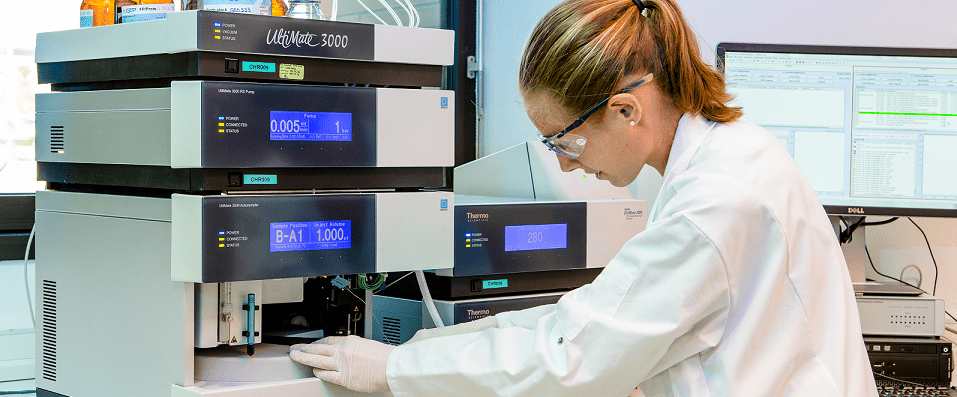The best way for biotech companies to address the analytical development of their biotherapeutic candidates at preclinical and clinical stages.
Choosing the right QC development process and subcontractor for your project
Characterising a therapeutic biomolecule is a complex task. With regulatory guidance evolving between phase I and phase III – constraints being significantly lower for the first phase than for the last one – the choice of a relevant analytical package to support each stage in the development of your product is not an easy one.
Benefits of early characterisation
For biotech companies, each strategic decision in the product development process is a balancing act between risk, time and cost. Take for example the choice of what level of characterisation to aim for during process development, and that of the QC methods to analyse the bioproduct: whilst time and budget constraints dictate that there is a need to minimise the effort put into QC development, it is also necessary to ensure sufficient quality of the product, for safety reasons and in order to comply with regulatory guidance on clinical trials.
A risk-minimisation approach will tend to maximise the characterisation in early phases. This approach will, in itself, be time- and money-consuming, but it will also impact the whole development: the finer and more precise the characterisation, the more fine-tuning and development efforts required in order to obtain a robust process. Even if this approach is certainly the safer one, biotech companies, due to their financial structures, often succumb to the temptation of sticking with the minimum required, in order to ensure rapid entry into clinical phases. We have, unfortunately, seen several projects where too strong a focus on timelines at the start eventually led to dramatic delays later on.
Choosing an analytical package
After the strategic choice of a risked or derisked approach has been made, comes the choice of appropriate methods for characterisation – also a though one.
Large analytical CROs offer comprehensive lists of analytical services for the characterisation of biomolecules. But anyone inexperienced will have a hard time trying to select the appropriate methods from these “exhaustive catalogues”. Faced with barbaric abbreviations such as FFF, SEC MALS, DLS , ESI QTOF, ICP MS, TTIR, DSC, CE or cIE, who wouldn’t be a little confused? How to choose the right methods?
There are classic methods for quantification, identification and purification. But for other forms of characterisation that are key for a relevant analysis of your product, it might be trickier to properly weigh up different methods.
In most biotherapeutic development projects, aggregation analysis is key. It can significantly impact development efforts. It can be performed in various ways, such as subvisible particle analysis or light scattering methods (DLS, MALS) associated with size exclusion HPLC or field-flow fractionation. Whilst in most cases, standard SEC-HPLC might be sufficient during development, we recommend coupling it with additional methods to ensure that aggregated material is not trapped in the column (through DLS analysis for example). We believe this should be done from the start of the project to avoid trouble at later stages.
Another important question, and one of the key difficulties in this type of projects, is the characterisation of post-translational modifications, including of course glycans, but also for example oxidation deamidation. For small biotech companies, who cannot afford full characterisation in the same way large biotechs and pharmas can, it is very important to strike a good balance between a minimal characterisation that is sufficient for IND application, and one that is enough to allow for early detection of a too difficult molecule, putting an end to the project before having spent too much time or money on development.
For glycosylation, our partner PROTEODYNAMICS recommends analysing glycan profiles early on, when the first research batches of the protein become available. This allows to observe the variability of the profile during process development, and to determine a reference profile to compare glycosylation between different batches produced.
Some difficulties can also be faced with HCP quantification. Generic ELISAs available on the market (Cygnus, BioGenes, Bioreliance…) are the gold standard from preclinical phase to clinical phase II. But for phase III clinical trials, regulators expect a process-specific ELISA, using polyclonal antibodies specifically developed to perfectly cover the whole HCP proteome expressed by the host organism. Our partner ID Biotech, which specialises in ELISA development, recommends switching to a process-specific ELISA as early as possible to decrease the risk on the project. They also propose to help biopharma companies select the most suitable generic assay to use during development by evaluating different commercial immunoreagents.
Conclusion
In order to develop a process in agreement with the latest regulatory guidance, and to include QbD (Quality by Design) from an early stage, we think that, while focusing on the main objectives and the requirements of early clinical phases, it is also crucial to consider a deep characterisation early on in development. These investigations can initially be conducted even with non-fully validated or qualified methods. We believe that partnerships with a CMC consultant and small specialised CROs are the best option for biotech companies developing their first products.



